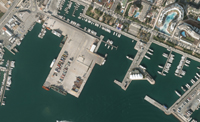
The Port of Ibiza tenders the work to improve the berthing line on the Commercial Quays
Eivissa
08/07/2014
The Port Authority of the Balearic Islands (APB) has tendered the work to redesign and improve the structure of the South Ro-ro Quay and the Fuel Quay at the Port of Ibiza. The budget for the tender is €9,181,44.96, and the maximum execution period has been set at 15 months. The work will be carried out in two phases, so at least one of the two quays will remain operational at all times.
The project consists of replacing the current piling structure, which has deteriorated over time, with sheet-piling, thus making the quays stronger and more durable. The improvement work will be carried out on a surface area of 8,352 square metres, which includes two Ro-ro ramps for loading and unloading, and the berthing lines on the South Ro-ro Quay and the Fuel Quay, located on the Commercial Quays at the Port of Ibiza. The deadline for bids is 18th August.
Deterioration
The South Ro-ro Quay was built in 1969 in line with the project entitled “Jetty for unloading fuel at the Port of Ibiza”. However, the current make-up of the berthing faces on the South Ro-ro and Levante Ro-ro (or Fuel) Quays is the result of several subsequent actions that were implemented at different times, and was not completed until 1998, via the project known as the “Platform for Ro-ro traffic on the east berthing face of the Commercial Quays at the Port of Ibiza”.
On 28th March 2012, the APB inspected the underside of the superstructure on both quays and published a report about its condition. The pathologies that were detected (cracks in the deck, loss of reinforcement cover and buckling both on the deck and in the piling, and some piles which were about to collapse) are likely to affect the service and structural safety of the quays. Accordingly, a decision was made to take global action on the quays to ensure the correct functionality and structural resistance of these infrastructures.







